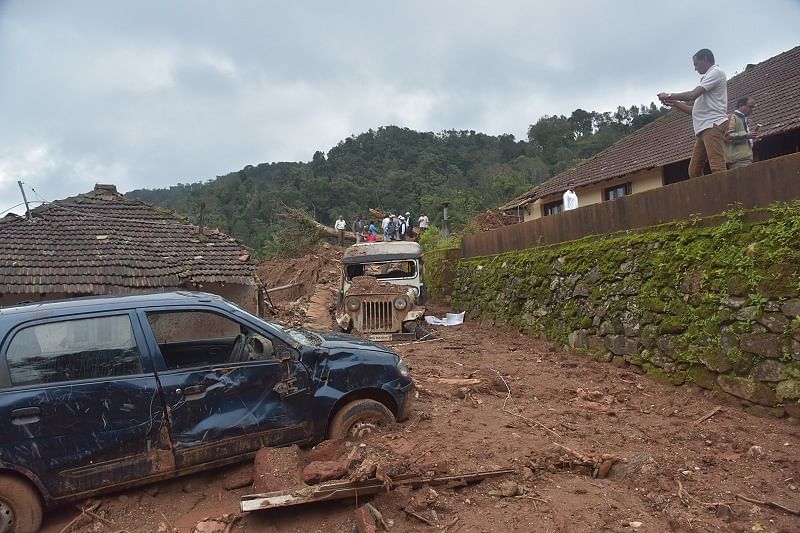
Landslides are silent killers. They are as deadly as any other natural catastrophes but receive far less attention in the public space. This could possibly be the reason for people not considering the threats and consequences of a landslide while going ahead with reckless construction in the hills. Often, reality dawns too late in the day.
An international database of fatal landslides prepared by the University of Sheffield, England shows that with close to 11,000 deaths due to landslides in 12 years, India tops a global list of nearly 56,000 casualties from 4,800 landslides around the world between 2004 and 2016.
MUST READ: Illegal quarries create quandaries for Keralites
Western Ghats on a ticking time bomb
India not only accounts for 20% of landslide deaths but also has the dubious distinction of witnessing the fastest rise in human-triggered fatal landslides. The trigger comes from legal and illegal mining, hill cutting, construction, dam collapse and pipe leaking, besides known natural causes like rainfall and quakes.
Of the 4,862 non-seismic events in the database, 770 cases (16%) were generated by man-made triggers, resulting in 3,725 fatalities. The majority of the landslides were triggered by mining (232 multi-fatality and 67 single-fatality events), construction (170 and 140) or illegal hill cutting (60 and 27).
Country-wise, the most construction-triggered landslide events occurred in India (28%), followed by China (9%), Pakistan (6%), the Philippines (5%), Nepal (5%) and Malaysia (5%), the researchers had reported in the European Geo-sciences Union’s journal Natural Hazards and Earth System Sciences last year.
Regulations not followed
The statistics, however, don’t mean much to people and policymakers in the hills. A visit to almost any part of the western Himalayas will show mindless construction and mushrooming of buildings. There’s hardly any town planning and people looking to make a quick buck from tourism care little due to non-enforcement of regulations.
Western Ghats are no exception. Almost every heavy rain brings down a part of the hill in southern states and last year was particularly devastating. A landslide inventory created by Indian space scientists shows as many as 6,970 landslides were triggered by the heavy downpour of August 2018 out of which 5,191 happened in Kerala, 993 in Karnataka and 606 in Tamil Nadu.
In Karnataka, the maximum number of landslides were recorded in Kodagu district (771) followed by Dakshina Kannada (88), Chikkamagaluru (34), Hassan (74) and Udupi (26).
“Although the highest number of landslides was mapped in Idukki (1,632), the total area of landslides was maximum in Kodagu due to debris flows with multiple crowns coalescing into the valley,” a team of five scientists from the National Remote Sensing Centre, Hyderabad, one of the institutes under the Indian Space Research Organisation, wrote in a research paper published in the journal Current Science last month.
Kerala bore the brunt of excess rainfall last year, but adjacent states of Karnataka and Tamil Nadu too witnessed landslides resulting in damage to plantations of cash crops like coffee and spices besides destroying the tourism infrastructure.
Source: Global fatal landslide occurrence from 2004 to 2016 University of Sheffield
Asked about the southern landslides, Dave Petley at the University of Sheffield said, “Kerala and parts of Karnataka are undoubtedly naturally landslide-prone because of the combination of monsoon rainfall and upland areas. But human activities are exacerbating these problems. The occupation of dangerous areas, inadequate water management, poor construction practices, road construction, quarrying and hill cutting all contribute to increased landslide hazard.”
“The 2018 landslides in Kerala and southern Karnataka after heavy rains have been a continuation of these problems,” Petley told DH.
“Humans are placing increasing pressure on their local environment but it was surprising to find clear trends that fatal landslides triggered by construction, illegal hill cutting and illegal mining were increasing globally during the period of 2004 to 2016. While the trend is global, Asia is the most affected continent. All countries in the top 10 for fatal landslides triggered by human activity are located in Asia,” pointed out Melanie Froude, another researcher from the University of Sheffield.
